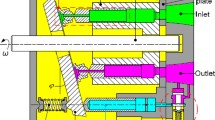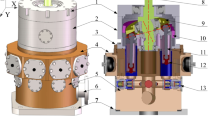Abstract
Piston theory is widely used in modeling unsteady aerodynamic loads. The piston theory exhibits different nonlinear characteristics under variant conditions. However, the theoretical study regarding the influence of these conditions only receives limited attention, impeding the accurate applications of piston theory in engineering practice. Based on previous researches, the current study theoretically investigates the influence of structural mode shape and vibration frequency on the nonlinear characteristics of piston theory. Corresponding to different engineering problems, three different structural mode shapes are proposed. For a wedge-like mode shape under one-side flow, the flow nonlinearity is significant and consists of 40% of aerodynamic loads, while the flow only exhibits linear features for a sharpened sine-wave-like mode shape under one-side flow and control surface under two-side flow. The analysis shows that the mode shapes can significantly influence the nonlinearity of piston theory through the interaction between linear and nonlinear aerodynamic components in different regions of the structure. Moreover, the vibration frequency has a major influence on the nonlinearity and validity of piston theory. Due to the interaction between high-order terms in piston theory, the flow nonlinearity is insignificant at intermediate frequency (200–300Hz), while the nonlinearity at lower and higher frequencies becomes significant. The piston theory becomes invalid with decreasing frequency, but applicable when the frequency reaches 0.


















Similar content being viewed by others
References
Ye, Z.Y., Meng, X.Z., Liu, C., Ye, L.Q.: Progress and prospects on aeroelasticity of hypersonic vehicles. Acta Aerodyn. Sin. 36, 984–994 (2018). https://doi.org/10.7638/KADLXXB-2018.0060
Liguore, S., Tzong, G.: Identification of Knowledge Gaps in the Predictive Capability for Response and Life Prediction of Hypersonic Vehicle Structures. In: 52nd AIAA/ASME/ASCE/AHS/ASC Structures, Structural Dynamics and Materials Conference. pp. 1–9.,s Denver, Colorado (2011)
Meng, X., Ye, Z., Hong, Z., Ye, K.: Influences of wall vibration on shock train structures and performance of two-dimensional rectangular isolators in scramjet engine. Acta Astronaut. 166, 180–198 (2020). https://doi.org/10.1016/j.actaastro.2019.09.035
Meng, X., Ye, Z., Hong, Z., Ye, K.: Impacts of panel vibration on shock train structures and performance of two-dimensional isolators. Aerosp. Sci. Technol. 104, 105978 (2020). https://doi.org/10.1016/j.ast.2020.105978
Meng, X., Ye, Z., Ye, K.: Effects of flexible panels on normal shock trains and performance of scramjet isolators. Aerosp. Sci. Technol. 110, 106455 (2021)
Meng, X., Ye, Z., Ye, K., Liu, C.: Analysis on location of maximum vibration amplitude in panel flutter. Proc. Inst. Mech. Eng. Part G J. Aerosp. Eng. 234, 457–469 (2020). https://doi.org/10.1177/0954410019876529
Eason, T.G., Spottswood, S.: A Structures Perspective on the Challenges Associated with Analyzing a Reusable Hypersonic Platform. In: 54th AIAA/ASME/ASCE/AHS/ASC Structures, Structural Dynamics, and Materials Conference. , Boston, Massachusetts (2013)
Liu, W., Zhang, C.-A., Han, H.-Q., Wang, F.-M.: Local piston theory with viscous correction and its application. AIAA J. 55, 942–954 (2015). https://doi.org/10.2514/1.j055207
Guruswamy, G.P.: Unsteady aerodynamic and aeroelastic calculations for wings using euler equations. AIAA J. 28, 461–469 (1990). https://doi.org/10.2514/3.10415
Huang, D., Rokita, T., Friedmann, P.P.: Integrated aerothermoelastic analysis framework with application to skin panels. AIAA J. 56, 4562–4581 (2018). https://doi.org/10.2514/1.J056677
Brouwer, K.R., McNamara, J.J.: Enriched Piston Theory for expedient aeroelastic loads prediction in the presence of shock impingements. AIAA J. 57, 1288–1302 (2019). https://doi.org/10.2514/1.j057595
Dowell, E.H.: Panel flutter-a review of the aeroelastic stability of plates and shells. AIAA J. 8, 385–399 (1970). https://doi.org/10.2514/3.5680
Dowell, E.H.: Nonlinear oscillations of a fluttering plate. AIAA J. 4, 1267–1275 (1966). https://doi.org/10.2514/3.4316
Dowell, E.H.: Nonlinear oscillations of a fluttering plate. II. AIAA J. 5, 1856–1862 (1967). https://doi.org/10.2514/3.4316
Meng, X., Ye, Z., Liu, C.: Nonlinear analysis on Piston Theory. AIAA J. 57, 4583–4587 (2019). https://doi.org/10.2514/1.J057698
Meng, X., Ye, Z., Ye, K., Liu, C.: Aerodynamic nonlinearity of Piston theory in surface vibration. J. Aerosp. Eng. 33, 1–12 (2020). https://doi.org/10.1061/(ASCE)AS.1943-5525.0001148
Mei, C., Abdel-Motagaly, K., Chen, R.: Review of nonlinear panel flutter at supersonic and hypersonic speeds. Appl. Mech. Rev. 52, 321–332 (1999). https://doi.org/10.1115/1.3098919
Brouwer, K.R., Gogulapati, A., McNamara, J.J.: Interplay of surface deformation and shock-induced separation in shock/boundary-layer interactions. AIAA J. 55, 4258–4273 (2017). https://doi.org/10.2514/1.J056030
Spottswood, S.M., Eason, T.G., Beberniss, T.: Influence of shock-boundary layer interactions on the dynamic response of a flexible panel. In: International Conference on Noise and Vibration Engineering (ISMA). pp. 603–616. , Leuven (2012)
Spottswood, S.M., Beberniss, T.J., Eason, T.G., Perez, R.A., Donbar, J.M., Ehrhardt, D.A., Riley, Z.B.: Exploring the response of a thin, flexible panel to shock-turbulent boundary-layer interactions. J. Sound Vib. 443, 74–89 (2019). https://doi.org/10.1016/j.jsv.2018.11.035
Daub, D., Willems, S., Gülhan, A.: Experimental results on unsteady shock-wave/boundary-layer interaction induced by an impinging shock. CEAS Sp. J. 8, 3–12 (2016). https://doi.org/10.1007/s12567-015-0102-4
Willems, S., Gülhan, A., Esser, B.: Shock induced fluid-structure interaction on a flexible wall in supersonic turbulent flow. Prog. Flight Phys. 5, 285–308 (2013). https://doi.org/10.1051/eucass/201305285
Daub, D., Willems, S., Gulhan, A.: Experiments on the interaction of a fast-moving shock with an elastic panel. AIAA J. 54, 670–678 (2016). https://doi.org/10.2514/1.J054233
Visbal, M.: Viscous and inviscid interactions of an oblique shock with a flexible panel. J. Fluids Struct. 48, 27–45 (2014). https://doi.org/10.1016/j.jfluidstructs.2014.02.003
Ye, L.-Q., Ye, Z.-Y.: Effects of Shock Location on Aeroelastic Stability of Flexible Panel. AIAA J. 56, 3732–3744 (2018). https://doi.org/10.2514/1.j056924
Brouwer, K.R., McNamaray, J.J.: Rapid modeling of aeroelastic loads in the presence of shock impingements. AIAA/ASCE/AHS/ASC Struct. Struct. Dyn. Mater. Conf. (2018). https://doi.org/10.2514/6.2018-1448
Gogulapati, A., Deshmukh, R., McNamara, J.J., Vyas, V., Wang, X.Q., Mignolet, M., Beberniss, T., Spottswood, S.M., Eason, T.G.: Response of a panel to shock impingement: Modeling and comparison with experiments - part 2. 56th AIAA/ASCE/AHS/ASC Struct. Struct. Dyn. Mater. Conf. (2015). https://doi.org/https://doi.org/10.2514/6.2015-0685s
Miller, B.A., Crowell, A.R., Deshmukh, R., Gogulapati, A., McNamara, J.J., Vyas, V., Wang, X., Mignolet, M.P.: Response of a Panel to Shock Impingement: Modeling and Comparison with Experiments. In: 55th AIAA/ASME/ASCE/AHS/ASC Structures, Structural Dynamics, and Materials Conference. , National Harbor, Maryland (2014)
Meijer, M.-C., Dala, L.: Generalized Formulation and Review of Piston Theory for Airfoils. AIAA J. 54, 17–27 (2016). https://doi.org/10.2514/1.j054090
Anderson, J., Jr.: Fundamentals of Aerodynamics. McGraw-Hill, New York (2001)
Funding
This study was funded by the National Natural Science Foundation of China under the Grant No. 11732013 and National Numerical Windtunnel under the Grant No. NNW2019ZT3-A15. The authors would like to express their sincere gratitude for the financial support that permitted the continuous conduct of this research.
Author information
Authors and Affiliations
Corresponding author
Ethics declarations
Conflict of interest
The authors declare no conflicts of interest with the publication of this work.
Additional information
Publisher's Note
Springer Nature remains neutral with regard to jurisdictional claims in published maps and institutional affiliations.
Rights and permissions
About this article
Cite this article
Meng, X., Ye, Z. & Liu, C. Influence of vibration characteristics on the nonlinearity of piston theory. Acta Mech 232, 3091–3105 (2021). https://doi.org/10.1007/s00707-021-02934-5
Received:
Revised:
Accepted:
Published:
Issue Date:
DOI: https://doi.org/10.1007/s00707-021-02934-5




